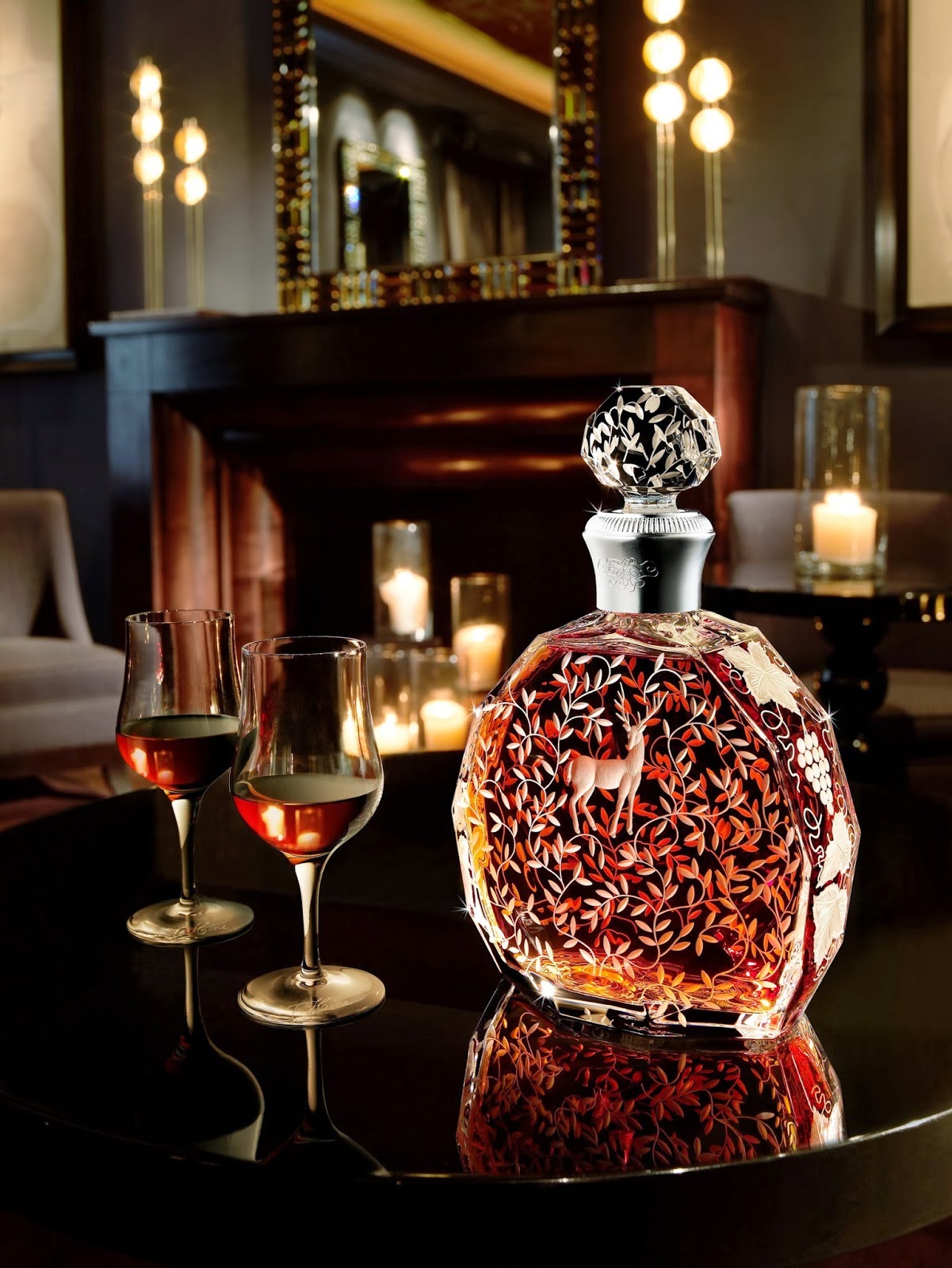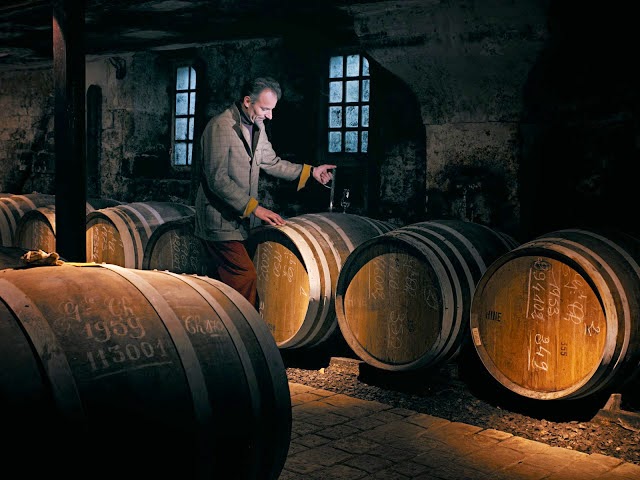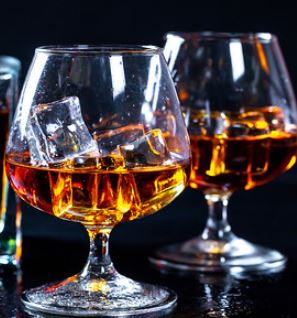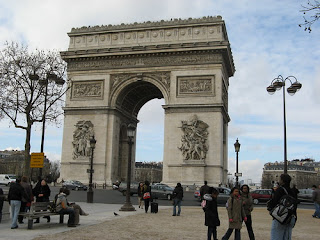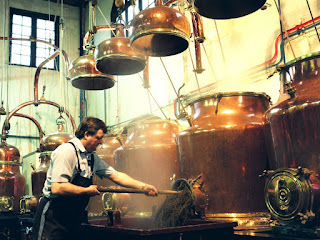Cognac Snifter
From the cognac museum in Moscow
AOC/AOP
Can any digestif be better than a Cognac,
after an enjoyable meal?
I think not.
All French Cognacs are entitled to use the initials AOC and
AOP.
The Cognac labels.
Cognac houses, the Cognac producers,
print on the labels their Cognacs' brand name. Included, along with legally
required specifications, they often add awe-inspiring detail. Apart from their
labels, many Cognacs bottles are themselves works of art. Despite that, their
design has no connection to the quality of the Cognac. Among all the extraneous
material look on the label for the following:
The legal age of the
Cognac in the bottle.
The labels and or packaging may indicate
the ages of the older eau-de-vies. Cognacs begin as wines. When they have been
distilled, they become eau-de Vies; distilled grape liquors. They only become a
Cognac when they have been blended. Never mind the age of the oldest
eau-de-vies on the label. The legal age of the Cognac is the age of the
youngest eau-de-vie used in the blend.
The age is shown cryptically with symbols
such as ***, or initials such as VSOP.
Words such as Extra or Napoleon may also
be used. Five paragraphs further down this post all these symbols and initials,
with their meanings, are listed.
A Cognac's grade
If a Cognac is graded by using the French
word "Cru," the label will show that. Apart from affecting the taste
of a Cognac, the cru will also affect your wallet. Cognac mavens use the labels
to narrow their choices; however, knowing the legal markings are only a
fraction of a great Cognac's story.
The Talent Cognac
This Talent (brand name) Cognac was created in 1991 by Bernard and
Jaques Hine.
It commemorates the bi-centenary of their ancestor’s arrival in
France, from England. Included in the price of this Cognac is
the exclusively designed Baccarat Crystal decanter shown in
the picture.
Photograph by Gilles de Beauchên, courtesy of HINE.
The minimum age of a Cognac.
After
at least two years in oak barrels, young eau-de-vies may be blended with other
eau-de-vies; only then they may be called a Cognac.
N.B. there are said to be old Cognacs made with a single,
unblended, vintage. These would be extremely expensive Cognacs. They may be out
there, but I have only heard rumors.
Cognac
blends and ages.
A Cognac blend may include four, six, ten, or even
thirty-year-old brandies. However, if a single drop of a two-year-old
eau-de-vie is included in the Cognac, all the producers may show for the legal
age of this Cognac is a two-year-old Cognac.
The
legal initials, symbols, and names for age on Cognac labels.
Two years
V.S., (Very Special), or ***, Three Stars Sélection and De Luxe – On the label for a Cognac where the youngest eau-de-vie in the blend was matured in oak barrels for at least two years.
Three yearsSupérieur, Cuvée
Supérieure and Qualité Supérieure – These labels
may be used for Cognacs with the youngest eau-de-vie matured in oak barrels for at least three
years.
Four Years V.O., (Very Old); V.S.O.P. (V.S.O.P.),
(Very Superior Old Pale), Réserve, Vieux, Rare and Royal – The youngest
eau-de-vie in these Cognacs will have been matured in oak barrels for at least
four years.
Five yearsVieille
Réserve, Réserve Rare and Réserve Royale -
These labels may be used for Cognacs with the youngest eau-de-vie matured for
at least five years.
Six yearsNapoléon, Très
Vieille Réserve, Très Vieux, Héritage, Très Rare, Excellence and Suprême - These labels may be used for Cognacs with the youngest eau-de-vie
matured in oak barrels for at least five years.
Ten years X.O., (X.O.), (Extra Old); Vielle Réserve,
(Ancient Reserve); Extra; (Extra), Hors d'Âge, (Too old to determine), Ancêtre (Ancestral)
« Ancêtre, Gold, Impérial – All the eau-de-vies in these Cognacs will have been aged for at
least ten years in oak barrels.
Fourteen yearsXXO (Extra
Extra Old) - All the
eau-de-vies in these Cognacs will have been aged for at least 14 years in oak
barrels.
Differences
between the ages in the list above
The Cognac producers' organization, the B.N.I.C. (the
Bureau National Interprofessionnel du Cognac), accepts that there are differences
between each Cognacs' age grouping. However, these differences are the
producers' provenance; they are not the law.
A night view of Cognac across the River Charente.
Photograph courtesy of Hellebardius
Cognacs older than six years
To taste a very old Cognac, you will need to be extremely lucky, or be willing to pay an extraordinarily high price. If you are in the town of Cognac and extremely lucky, the maître de chai, the cellar master and master blender of a Cognac house may invite you to try a real twenty-year-old cognac. By that, I mean a Cognac none of whose eau-de-vies in the blend are younger than twenty years. You would, no doubt, enjoy an unparalleled and extremely rare Cognac; a twenty-year-old blend with no eau-de-vies younger than 20 years. You may know the true age of the youngest Cognac in the bottle; however, for sale, the label may only show the same markings as a Cognac with a six-year eau-de-vie in the blend. There is no legal marking for a twenty-year-old blend.
Checking aging Cognac in the Chai, the cellar.
Photograph Eric Forget courtesy of Cognac HINE.
The crus, the grades, on Cognac labels.
French
wine-growing areas are divided by appellations, which legally limits the area
where a particular wine used for Cognac may be grown. Within appellations, some
wines are then separated by crus, grades in English. The crus were allocated to
areas whose grapes produced superior wines. For Cognac, the crus
reflect the ratings among vineyards and the quality of the white wine grapes
that grow there; that rating may under certain conditions be transferred to the
bottled Cognac’s label.
There
are six Cognac crus, each cru equaling a grade. However, there are seven
grades. That grade was set between the first and second crus. These grades may
be on the labels. The map below shows the six Cognac cru’s growing areas.
The Cognac growing areas with the
Cognac Crus.
Map courtesy of BilzOr.Based on the original by Alain Peaudeau, Membre du Club Rando-photo
The Crus
The first is Grande Champagne:
Grande
Champagne, also called Grande Fine Champagne. This is the area with the highest
rated vineyards.
NB. The
word Champagne in Cognac labels has nothing to do with the wines called
Champagne including the famous sparkling Champagne wines. The wines come
from the area that begins just one hour north of Paris. The
origin of the word champagne is related to the Roman word for a type of soil.
Not a Cru but still the second level is Fine Champagne:
Fine
Champagne is not a separate cru as there are no Fine Champagne
vineyards. Fine Champagne represents the second level in Cognac
grades. It is made with grapes from the first and second crus. At least 50% of
the eau-de-vies used in this blend must come from first cru Grand Champagne
vineyards.
NB. The
name Fine Champagne is not to be confused with the name of the first cru noted
above. That first cru may be called Grande Fine
Champagne. Don’t blame me for any confusion that results; I did
not allocate the names! Fine Champagne and Grande Fine Champagne
Cognacs are from different grades.
Petite Champagne:
Petite
Champagne also called Petite Fine Champagne; the second-highest cru and the
third grade.
Then comes four more crus:
Borderies:
Borderies;
the third cru vineyards.
Fins Bois:
Fins
Bois; the fourth cru vineyards.
Bons Bois:
Bons
Bois; the fifth cru vineyards.
Bois Ordinaires and Bois Communes.
Bois
Ordinaires and Bois Communes: the sixth cru
vineyards. Bois Ordinaires and Bois Communs may be the sixth cru,
but they are certainly not the least.
Ungraded Cognacs
However, well-aged and blended, and despite their
great taste and aroma, and however magnificent their packaging, Cognacs made
from two or more crus may not mention any cru. The singular exception to that
rule is the blend made with the first and second crus Grande Champagne and Fine
Champagne noted above.
The areas divided into crus were laid out long ago.
None of the recent changes in agriculture, blending techniques, or the actual
taste are represented on the label. The lack of a cru on the label does not
mean a very poor Cognac. The lack of a cru on the label is only one among the
many rules that affect the final taste, aroma, and that je ne sais quoi,
of an excellent Cognac.
Some like ice in their Cognac.
www.flickr.com/photos/30478819@N08/32625830898
Cognac crus were established 150
years ago
based on soil and other tests.
Since the Crus were established they have been part
of French law since 1909. No cru has ever been changed. With tremendous
prestige behind the best crus, not to mention enormous financial investments,
it may be another 150 years until Cognac crus and their growing areas are
revisited.
French Cognac with English names
on the labels.
Nearly all of the initials and names used to describe
a Cognac's age are in English. That should not be surprising as the English were
also behind the popularity of Bordeaux wines, Port, Sherry, Rum, Madeira,
Marsala wine, and, of course, gin. In
the 17th century, the Cognac house's most significant customers were the
English, and the English being English, only placed their orders in English.
Additionally, two of the most famous Cognac houses had English founders and a
third was Irish.
English names on the labels.
Before Cognac was called Cognac, all these
brandies were sold as Eau-de-Vies de Cognac or Eau-de-Vies de Charentes. From
those early days, the usage of English for these brandies' age was the accepted
standard. When France set legal standards for Cognac labels, the English names
and initials remained.
French names on Cognac labels
French names do appear on the labels of some Cognacs
that are at least six-years-old. Hors d'Age is one example; it means too old to
determine. Hors d'Age was added by French Cognac Houses, who claimed older
brandies than those using the X.0. marking. Noen the less, both markings, until
2016 when XO changes, have precisely the same legal meaning. Six years of age.
Napoleon Cognacs.
Legal permission to use the name Napoléon for Cognacs
at least six-years-old was given in 1936. By then, there were no Napoleons
around to claim the copyright. The name is said to relate to the preference of
Napoléon I for this brandy. However, while Napoléon, his nephew Napoléon III, and
I lived no brandy from the area of Cognac carried either of the Emperors'
names. Napoléon III did give a Royal Warrant to the Cognac house Courvoisier in
1869, and today Courvoisier calls itself Le Cognac de Napoléon. Other Cognac
houses use the name Napoleon for their six-year-old Cognacs.
The Arc de Triumph in Paris.
The arch was begun by Napoleon I to memorize his victories.
https://www.flickr.com/photos/bruchez/400331291/sizes/m/
Where does Cognac come from?
Cognac comes from grapes grown in the beautiful
departments of Charente, Charente-Maritime, Deux-Sèvres, and Vienne. These
departments were part of Poitou-Charentes in southwestern France. Since
1-1-2016, they are included in the new super region of
Nouvelle Aquitaine. The area is well known for its great shellfish, goats'
cheeses, AOC butters, AOC new
potatoes, melons, truffles, and much much more. Some of the grapes for Cognacs
come from vineyards in the department of the Dordogne in Aquitaine, itself a
magnificent center for other wines, Cuisine a la Périgordien,
black truffles and more.
Where does Cognac come from?
Cognac comes from grapes grown in the beautiful
departments of Charente, Charente-Maritime, Deux-Sèvres, and Vienne. These
departments were part of Poitou-Charentes in southwestern France. Since
1-1-2016 they are included in the new super region of Nouvelle Aquitaine. The area
is well known for its magnificent shellfish, goats’ cheeses, AOC butters, AOC new potatoes, melons, truffles
and much much more. Some of the grapes for Cognacs come from vineyards in the
department of the Dordogne in Aquitaine, itself a magnificent center for other
wines, Cuisine a la Périgordien, black truffles and more.
The Cognac producing departments.
Below, and to the left, is the region of the Gironde with the city of Bordeaux.
© Google Maps.
Who produces Cognac?
In the center of this genuinely distinctive region is the town of Cognac that gave its name to this 40% alcohol grape brandy. The Cognac region is vast and includes the islands Ré and Oléron, off France’s Atlantic coast. Within the growing area of Cognac, there are over 5,000 vignerons, owners of vineyards. Nevertheless, less than 300 of these vignerons sell a Cognac with their name, their own brand, on the label. Less than 50 Cognac producers with their own brands are known outside of France.
A number of famous Cognac houses, in fact, own no vineyards at all. These Cognac houses buy their grapes, or young eau-de vies from growers. A Cognac house’s knowledge and art in aging and blending Cognacs, and merchandising the final product makes them famous, not growing the grapes.
A number of famous Cognac houses, in fact, own no vineyards at all. These Cognac houses buy their grapes, or young eau-de vies from growers. A Cognac house’s knowledge and art in aging and blending Cognacs, and merchandising the final product makes them famous, not growing the grapes.
Cognac
barrels in the cellar.
www.flickr.com/photos/dunleavy_family/9467244674/
A clarification of two of the words used in this post:
The origin of the word brandy.
The Dutch were among the most influential traders in the Old and
New Worlds. They were the first serious buyers of the wines from the area now
called Cognac. When the Dutch bought the wines from the area that would
become Cognac, they transported them, in barrels, to
Holland. Unfortunately, back in Holland, they found these wines did
not travel well and would not sell as wine. To safeguard their investment the
Dutch distilled these not so brilliant wines; the result was a magical liquor. The
Dutch called this liquor brandewijn, meaning burnt wine. Brandewijn was the
word that would become brandy.
Ten liters of wine makes one liter of brandy and the Dutch realized
that distilling the wines where they were made would save a great deal of space
on their ships. Distilling the liquor in the area around the town of
Cognac was a momentous decision. In the first case, it saved the Dutch shipping
costs. In the second case, this allowed the French to see that brandy
distillation was a growing business. The French copied the Dutch and
opened their own distilleries. Then the French came up with a second
distillation that is still used today. That second distillation allows for a
smoother liquor.
Then came the English
The English were the largest buyers of wines in nearby
Bordeaux. They traveled a few miles north and crossed to the other side of
the River Gironde to see what was being sold near the town called
Cognac. Following their second distillation, the French distillers
discovered that allowing the brandy to spend more time in oak barrels improved
the taste and color. The English quickly became the largest buyers of
brandy. As quickly as they could age the brandy and that was at least two
years they had customers standing in line. Aging and blending the eau-de-vies
from different years produced many excellent and different brandies and
among them Cognac became the most famous.
The meaning of Eau-de-vie.
For the area of Cognac, an eau-de-vie means a grape alcohol made
from a wine that has been distilled twice. In other areas of France, an
eau-de-vie may mean a distilled fruit brandy, and the French have many notable
fruit brandies. On a carte des digestifs, a list of recommended
after-dinner drinks, Cognacs, Armagnacs, Calvadoses, and eau-de-vies will be separated. The eau-de
vies on the list will be fruit brandies.
The words eau-de-vie are the French translation of the Latin words
aqua vitae; in English the water of life. Aqua vitae were the
words used for certain alcoholic products produced by the Romans. When the
Romans occupied France and Britain and elsewhere the translations of the words
aqua vitae were taken into the local languages. Despite the Roman’s knowledge
of wine-making, the distillation of wines into liquors only came about hundreds of
years later, probably in 13th century by monks in Europe.
What else did the Romans bring?
The words aqua vitae were also taken into Scottish and Irish
Gaelic. According to Dictionary.com and the World English
Dictionary, the Gaelic words for the water of life would eventually become
whisky in Scotland and whiskey (with an e) in Ireland.
We blame the Romans for many unnecessary things; they spent a lot
of time introducing the French and English to good roads, aqueducts, and
baths, etc. They also taught the French how to grow snails for food and how to make foie gras, fattened goose liver. The
Romans also brought apricot, cherry, peach and many other fruits
and trees into France. The Romans also knew how to make good wine, and they
added to the types of grapes grown in France.
I digress as I write as this is a blog on French cuisine so I
cannot cover even a shortened story of Cognac in one post. As I write
I pass along my own impressions together with what I have seen,
tasted, been told, shown or read. To cover the world of Cognac there are
four separate posts.
My annual visits to France, for work and pleasure,
allowed me to try and enjoy a number of Cognacs. Over many years and
many tests, I found a Cognac that suits my taste. That Cognac is a well-known brand and it is usually available wherever I travel and so I search
no more. For those who are still looking for their preferred Cognac,
read about the changes that occur in Cognac when they are stored and aged in
oak barrels in the post Cognac II and the aperitif of the Cognac region, Pineau de Charentes, Cognac III.
The other Cognac posts:
Cognac in other languages:
--------------------------------
Behind the French Menu
by
Bryan G. Newman
behindthefrenchmenu@gmail.com
Copyright 2010, 2013, 2017, 20.
--------------------------------
Searching for the meaning of words, names or phrases
on
French menus?
Just add the word, words, or phrase that
you are searching for to the words "Behind the French Menu" (best
when including the inverted commas), and search with Google, Bing, or another
browser. Behind the French Menu’s links, include hundreds of words,
names, and phrases that are seen on French menus. There are over 470 articles
that include over 4,000 French dishes with English translations and
explanations.
Beurre - Butter in French. Butter in French Cuisine.
Calvados – The Most Famous Apple Brandy in the World. Calvados on French Menus.
Calvados – The Most Famous Apple Brandy in the World. Calvados on French Menus.


